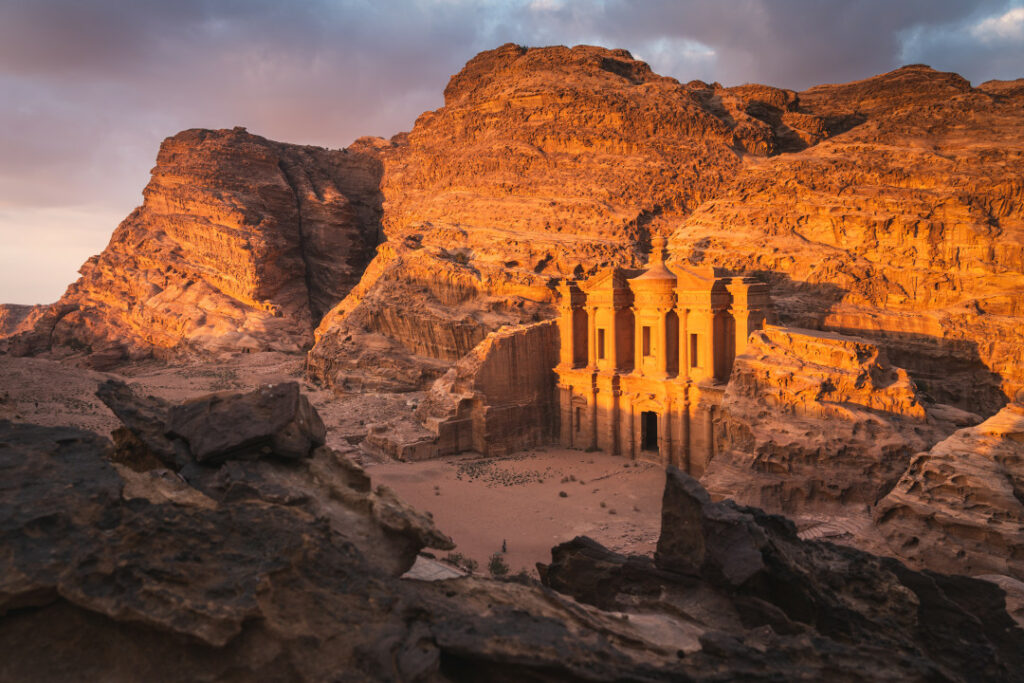Throughout history, tales of lost cities have captivated the human imagination, igniting the spark of curiosity and wonder. These mythical places, shrouded in mystery, have lured adventurers, explorers, and archaeologists on a quest to unravel their secrets and unlock the enigmatic stories buried beneath layers of time. Among these timeless wonders stands Petra, the legendary “Rose City” of Jordan, a place that has long enticed travelers with its magical allure and ancient splendor.
The Legend of Petra: An Introduction to the Rose City

Nestled amidst the rugged terrain of southern Jordan, Petra remains one of the most extraordinary archaeological sites in the world. Its allure lies not only in the breathtaking beauty of its rose-red sandstone cliffs but also in the mystique that surrounds its history. Petra’s origin can be traced back to the enigmatic Nabataean civilization, whose mastery of the desert landscape led to the creation of this once-thriving metropolis.
The tales of Petra’s grandeur and riches have echoed through the ages, evoking images of a lost city hidden from the outside world, accessible only through a narrow cleft in the mountains known as the Siq. As the story goes, Petra was a bustling center of trade, strategically positioned along the ancient caravan routes that crisscrossed the Arabian Peninsula, connecting the far reaches of the East to the heart of the Mediterranean.
The Nabataeans, a nomadic Arab tribe, settled in this natural fortress around the 4th century BCE, transforming it into a magnificent city that flourished for centuries. They harnessed the arid landscape, constructing an intricate water management system that brought life-giving water to the city, enabling the cultivation of lush gardens and sustaining a thriving society. The result was a stunning metropolis adorned with grand temples, majestic tombs, and elaborate facades carved into the rose-red cliffs.
For centuries, Petra remained a well-kept secret, known only to local Bedouin tribes who continued to inhabit the region. However, in 1812, Swiss explorer Johann Ludwig Burckhardt, disguised as an Arab traveler, made his way through the treacherous desert and stumbled upon the hidden city, forever unveiling the wonder of Petra to the Western world.
Since Burckhardt’s historic discovery, Petra has become a symbol of the ancient world’s ingenuity and a testament to the timeless connection between human civilization and its natural environment. The ruins of Petra have withstood the test of time, preserving the stories of a civilization that thrived and vanished, leaving behind an enigmatic legacy that continues to capture the imagination of modern-day adventurers, historians, and archaeologists.
In this exploration and insights article, we embark on a journey into the heart of Petra, delving into its ancient secrets, cultural heritage, and modern-day explorations. Join us as we peel back the layers of history and immerse ourselves in the mystique of the Rose City, uncovering the wonders that have enchanted the world for centuries. From ancient ruins to cutting-edge archaeological techniques, from the customs of the Bedouin tribes to the challenges of preserving Petra’s heritage, we delve into the past and present, painting a comprehensive picture of this extraordinary lost city. So, fasten your virtual sandals and join us on this adventure of a lifetime as we explore the eternal charm and enigmatic allure of Petra, the Rose City.
Discovering Petra’s Ancient Secrets

Unveiling the Lost City: A Glimpse into Petra’s History and Origins
The Nabateans: Masters of the Desert
To understand the enigma of Petra, we must first delve into the civilization that created it – the Nabateans. The Nabateans were a nomadic Arab tribe known for their exceptional skills in trade and commerce. In the 4th century BCE, they settled in the rocky desert of southern Jordan, where they established Petra as their capital.
The Nabateans’ mastery over the desert landscape was evident in their ingenious water management system. They channeled rainwater through a network of dams, cisterns, and aqueducts, ensuring a constant supply of water for their city. This water engineering allowed them to cultivate terraced gardens, turning the arid land into an oasis of greenery amidst the desert expanse.
From Caravan Routes to the Rose City: Petra’s Strategic Location
Petra’s strategic location played a vital role in its rise to prominence. Situated at the crossroads of major caravan routes, the city became a crucial trading hub, connecting the Arabian Peninsula with the Levant, Egypt, and beyond. Its strategic position allowed the Nabateans to amass wealth and influence, attracting merchants from diverse cultures and fostering a cosmopolitan society.
The Nabateans’ control over the trade routes and their ability to levy taxes on passing caravans contributed to the city’s prosperity. As a result, Petra’s wealth was evident in its grand architecture, elaborate monuments, and ornate facades that adorned its cliffs.
The Architecture of Petra: Magnificence in the Stone
Petra’s architecture is a testament to the Nabateans’ creativity and engineering prowess. The city’s iconic structures were carved directly into the rose-red sandstone cliffs, blending seamlessly with the natural rock formations. The facades of temples, tombs, and dwellings showcase intricate details and artistic flourishes that demonstrate the city’s wealth and artistic sophistication.
Among the most remarkable structures in Petra is the Treasury, also known as Al-Khazneh. This iconic facade stands as a symbol of Petra and serves as an awe-inspiring entryway to the ancient city. Beyond the Treasury lie numerous other architectural marvels, each with its own story to tell, revealing the richness and diversity of Nabatean culture.
The Great Temple of Petra: Unearthing the Heart of the City
Brown University Excavations: Insights from the Great Temple
The Great Temple stands as one of the most significant religious structures in Petra. Recent excavations by Brown University have shed new light on its significance and function within the ancient city. Archaeologists have uncovered remnants of a grand staircase, a monumental courtyard, and evidence of religious rituals that took place within its walls. The Great Temple’s discovery provides valuable insights into the Nabateans’ religious practices and social structure.
A Look Inside the Royal Tombs: The Nobility of Petra
Petra’s Royal Tombs, with their impressive facades and grandeur, have fascinated explorers for centuries. These tombs were reserved for the Nabatean elite and serve as a reflection of their wealth and status. Archaeologists have carefully studied the tombs, unearthing artifacts and inscriptions that offer glimpses into the lives of Petra’s nobility and their burial customs.
The Lost Treasures of Petra: Rediscovering Ancient Artifacts
The Petra Papyri: A Window into Nabatean Life
One of the most significant discoveries in Petra was the Petra Papyri – a collection of ancient texts written on papyrus. These documents offer valuable insights into the daily lives, trade, and administrative activities
Petra’s Rock Art: A Journey through Time
The rocky landscapes surrounding Petra are adorned with intricate rock art, representing a diverse range of cultures and civilizations that passed through the region over millennia. These ancient engravings offer a glimpse into the beliefs, customs, and daily lives of the people who once inhabited or traversed the area.
Nabataean Inscriptions: Decoding the Ancient Language
The Nabatean inscriptions found throughout Petra have posed a linguistic puzzle for researchers. While some inscriptions are in classical Nabatean, others appear in a hybrid form of Nabatean-Arabic script. Archaeologists and epigraphers continue to work on deciphering these inscriptions, piecing together the Nabatean language and unraveling the history of the city.
The Mystique of Petra’s Cultural Heritage

Petra and Religion: A Journey into the Nabataean Beliefs
The Role of Religion in Nabataean Society
Religion held a central place in the Nabataean society, shaping their daily lives, customs, and governance. The Nabataeans worshipped a pantheon of deities, reflecting the diverse influences of their multicultural interactions. Archaeological findings indicate that religious rituals were integral to the city’s functioning, with temples and sacred spaces scattered throughout Petra.
Nabataean Deities and Temples: Sacred Spaces in Petra
The architecture of Petra reveals the veneration of various deities. Temples dedicated to gods and goddesses such as Dushara, Al-‘Uzza, and Atargatis were places of worship and pilgrimage. The archaeological evidence suggests that the Nabataeans adopted religious practices from neighboring cultures, incorporating elements of Hellenistic and Roman religions into their own belief system.
The Influence of Hellenistic and Roman Religions on Petra
The Nabataeans’ strategic location at the crossroads of civilizations exposed them to a myriad of religious influences. During the Hellenistic and Roman periods, Petra became a melting pot of cultures, leading to the adoption of religious practices from Greece, Rome, and the broader Mediterranean world. This synthesis of beliefs enriched the spiritual fabric of Petra and contributed to the city’s unique cultural tapestry.
The Bedouin Tribes of Petra: Guardians of a Lost Legacy
The Bedouin Connection: Descendants of the Nabataeans
The Bedouin tribes living in and around Petra today trace their ancestry back to the Nabataeans. Their knowledge of the ancient city and its secrets has been passed down through generations, forming an invaluable link to Petra’s past. The Bedouins’ presence in Petra adds an authentic layer to the city’s mystique, and their insights provide archaeologists with valuable information about its history.
Traditional Bedouin Life: A Glimpse into the Past
The Bedouin way of life echoes the nomadic traditions of their Nabataean ancestors. Living amidst the ancient ruins, the Bedouins preserve the customs, crafts, and stories that have been handed down through centuries. Their close connection to the land and their respect for the ancient city imbue Petra with a sense of living history.
Cultural Preservation Efforts: Balancing Modernity with Tradition
As modernity encroaches upon traditional Bedouin life, there are challenges in preserving their unique cultural heritage. Efforts are being made to strike a balance between adapting to contemporary realities and safeguarding the cultural traditions that define the Bedouin identity. NGOs, local authorities, and international organizations are working together to ensure that Petra’s Bedouin heritage is protected and celebrated.
Petra’s Cultural Space: A UNESCO World Heritage Gem
The Importance of Preservation: Petra’s Inclusion in the UNESCO List
In recognition of its historical and cultural significance, Petra was inscribed on the UNESCO World Heritage List in 1985. This designation reaffirms the need to protect and preserve the ancient city for future generations. UNESCO’s recognition also draws global attention to the importance of safeguarding Petra’s cultural heritage and encourages sustainable tourism practices.
The Battle against Time: Challenges in Protecting Petra’s Heritage
As one of the world’s most iconic archaeological sites, Petra faces numerous challenges in preserving its heritage. Weathering, erosion, and the impact of tourism pose significant threats to the city’s delicate sandstone structures. Archaeologists, conservationists, and local authorities work tirelessly to implement measures that mitigate these risks and ensure the long-term survival of Petra’s treasures.
Community Engagement: The Role of Petra National Trust
Community engagement is vital in the conservation efforts at Petra. The Petra National Trust, in collaboration with local stakeholders and international partners, plays a critical role in safeguarding the ancient city. By involving the local community in preservation initiatives and promoting sustainable practices, the trust fosters a sense of ownership and pride in Petra’s cultural heritage.
As we continue our exploration of Petra, we will venture into the depths of the ancient city, unveiling more hidden treasures and unraveling its secrets. From its rock-cut dwellings to its magnificent monuments, every facet of Petra holds a piece of history waiting to be discovered. Join us as we embark on a journey through time and space to understand the allure and mystique of the Rose City.
The Modern-Day Explorations of Petra

Modern Archaeological Techniques: Unlocking Petra’s Secrets
Satellite Imaging: Aerial Perspectives of the Rose City
Advancements in satellite imaging have revolutionized archaeological research in Petra. Aerial views captured by satellites provide researchers with a comprehensive overview of the ancient city’s layout and architectural features. By analyzing these high-resolution images, archaeologists gain new insights into the scale and complexity of Petra’s urban planning.
Ground-Penetrating Radar: Exploring Hidden Chambers
Ground-penetrating radar (GPR) is a non-invasive technique used to detect buried structures and chambers beneath the surface. Archaeologists use GPR to explore unexcavated areas and locate hidden tombs, chambers, and underground structures within Petra. This cutting-edge technology has opened up new possibilities for uncovering hidden facets of the ancient city.
Drones and LIDAR: High-Tech Mapping of Petra’s Terrain
Drones equipped with Light Detection and Ranging (LIDAR) technology provide detailed three-dimensional maps of Petra’s terrain. LIDAR allows researchers to identify subtle variations in the landscape and map out archaeological features with remarkable precision. By employing these technologies, archaeologists gain a deeper understanding of the city’s topography and its historical context.
Conservation and Restoration: Preserving Petra for Future Generations
Petra’s Salt Weathering: The Challenge of Erosion
Petra’s sandstone facades are susceptible to salt weathering, a natural process that erodes the stone over time. Conservationists face the daunting task of protecting these delicate structures from environmental degradation. Through careful monitoring and intervention, experts strive to mitigate the impact of salt weathering and safeguard the integrity of Petra’s iconic monuments.
The Restoration of Petra’s Facades: A Delicate Art
Restoring the intricate facades of Petra requires a delicate balance between preservation and reconstruction. Skilled artisans and conservationists work meticulously to repair weathered surfaces while preserving the original aesthetics and historical authenticity. The restoration process honors the ancient craftsmanship while ensuring the longevity of Petra’s cultural heritage.
Sustainable Tourism: Balancing Preservation and Exploration
Petra attracts millions of visitors each year, making sustainable tourism a crucial consideration for its preservation. Balancing the exploration of this magnificent archaeological wonder with conservation efforts is essential to minimize the impact of tourism on the fragile site. Collaborative efforts between local authorities, tour operators, and the community aim to protect Petra’s heritage while offering visitors an enriching experience.
Documenting Petra’s Legacy: Exploration and Insights through Media
Literary Works: Stories of Petra’s Wonder and Mystery
Throughout history, writers, poets, and historians have been captivated by the enigma of Petra. Literary works, from travelogues to novels, have immortalized the allure and grandeur of the Rose City. These writings provide valuable insights into the impressions and perceptions of explorers who have ventured into the ancient site.
Filmmaking and Documentaries: Bringing Petra to the World
The mesmerizing beauty of Petra has inspired filmmakers and documentarians to capture its magnificence on the silver screen. Documentaries and films transport viewers into the heart of the ancient city, offering a visual feast that showcases Petra’s architectural wonders and rich history. These cinematic productions serve as a powerful tool to raise global awareness about the significance of preserving Petra’s legacy.
Television and Drama: Depicting the Enchanting Rose City
Television series and dramas set in Petra bring its history to life and weave captivating narratives around the ancient site. Through compelling storytelling, these productions ignite curiosity and fascination about the hidden tales of Petra. Such depictions serve as a gateway for audiences worldwide to connect with the cultural heritage and mysteries of the Rose City.
As we delve into the modern-day explorations of Petra, we witness how cutting-edge technologies and preservation efforts converge to protect this exceptional archaeological treasure. From ancient secrets unearthed through satellite imaging to the delicate art of facade restoration, Petra continues to enthrall us with its allure. Join us in the next chapter of our journey as we delve into the contemporary explorations and revelations that continue to enrich our understanding of Petra’s enigmatic past.
Adventures in Petra: A Personal Exploration

My Journey to Petra: From Dream to Reality
As an adventurer, archaeology journalist, and explorer, the legendary city of Petra has always held a magnetic allure for me. The tales of its grandeur, hidden tombs, and rock-carved facades filled my imagination since childhood. Finally, the day came when I embarked on a journey to fulfill my dream of uncovering the mysteries of Petra.
The Enchanting Siq: A Mystical Passage into Petra
My heart raced with anticipation as I entered the Siq, the narrow gorge that serves as the gateway to Petra. Flanked by soaring sandstone cliffs, the Siq weaves a mystical path through time. The play of light and shadow on the towering rock walls evoked an otherworldly atmosphere. With each step, I felt the weight of history envelop me, and I understood why this place was considered sacred by the Nabataeans.
The Treasury: Iconic Marvel of Petra
As the Siq gradually revealed its secrets, the Treasury emerged before me like a mirage from the past. Its majestic facade, adorned with intricate carvings, left me awestruck. The Treasury, known locally as Al-Khazneh, is Petra’s crowning jewel, and its ornate beauty lived up to every expectation. The sense of wonder and excitement was palpable as I gazed upon this ancient marvel, contemplating the tales of hidden treasure that once captivated explorers.
Beyond the Treasury: Exploring the Lost City’s Wonders
The Monastery: A Hidden Gem in the Mountains
Venturing further into Petra, I encountered the Monastery, another architectural masterpiece carved into the rugged mountains. The long hike to reach this remote site was rewarded with a sense of discovery and wonder. The Monastery’s sheer size and intricate details showcased the Nabataeans’ remarkable craftsmanship and devotion to their beliefs. Standing before it, I marveled at the thought of the ancient rituals that once took place here.
The High Place of Sacrifice: A Panoramic View of Petra
Seeking a panoramic view of the vast city, I ascended to the High Place of Sacrifice. The rocky plateau offered an unparalleled vista of Petra’s grandeur, surrounded by the striking Jordanian landscape. The name itself hinted at the rituals that once unfolded here, and the experience was one of both reverence and humility.
The Street of Facades: Echoes of the Past
The Street of Facades beckoned me onward, lined with ancient tombs and burial chambers. Each facade told a unique story of the people who once thrived in this bustling city. I imagined the vibrant colors that adorned these stone structures in antiquity, and the lively trade that once filled this historic thoroughfare.
Experiencing Bedouin Hospitality: Insights into Local Life
My explorations of Petra were not limited to its architectural wonders alone. I was privileged to interact with the modern-day guardians of this ancient legacy – the Bedouin tribes of Petra. Their hospitality and warmth welcomed me into their world, sharing their stories, traditions, and connection to the Nabataeans. It was a humbling experience that brought to life the continuity of human heritage through generations
Reflections on Petra: A Living Testament to Human Ingenuity
As I concluded my journey through Petra, I found myself reflecting on the timeless allure of lost cities and the human ingenuity that created them. Petra, with its blend of natural beauty and remarkable architecture, stands as a living testament to the resilience and creativity of ancient civilizations. The legend of Petra endures not only in its stone facades but also in the hearts of those who dare to explore its enigmatic past.
In the final part of our adventure, we delve into the enduring legacy of Petra in the modern world and the efforts undertaken to preserve its cultural heritage for generations to come. Join me as we unravel the threads of past and present, uniting in our appreciation of this extraordinary archaeological wonder.
Conclusion

Petra, the Rose City, is a place of eternal charm that captivates the hearts of adventurers, explorers, archaeologists, and travelers alike. Throughout this expedition, we have ventured into the realm of lost cities, tracing the footsteps of the ancient Nabataeans and unearthing the secrets they left behind. The allure of Petra lies not only in its majestic architecture but also in the sense of wonder it instills in all who stand before its magnificent facades.
A Journey of a Lifetime: The Eternal Charm of Petra
Our journey to Petra has been a testament to the enduring allure of ancient civilizations. The Nabataeans, masters of the desert, showcased their ingenuity and adaptability in carving a city into the very rocks. The strategic location of Petra along ancient caravan routes contributed to its prosperity and cosmopolitan character. The archaeological marvels of Petra, from the Great Temple to the Royal Tombs, have left us in awe of the craftsmanship and artistry of this ancient civilization.
Beyond the physical beauty of Petra, we have explored its cultural heritage and the sacred spaces dedicated to the Nabataean deities. The influence of Hellenistic and Roman religions interwoven with local beliefs reflects the city’s rich tapestry of cultural interactions. The Bedouin tribes, as the guardians of Petra’s legacy, have shared their stories and traditions, bridging the gap between the past and the present.
The Ongoing Quest: Unraveling the Enigmas of Petra
Yet, the quest to understand Petra is ongoing, and many enigmas remain. The language of the Nabataeans, hidden in inscriptions and papyri, awaits further deciphering to unlock the secrets of their daily lives and aspirations. Modern archaeological techniques, such as satellite imaging and ground-penetrating radar, offer new perspectives and opportunities for exploration. Conservation and restoration efforts are essential to safeguarding Petra’s delicate structures from the ravages of time and erosion.
Petra’s story continues to be documented through various media, from literary works to films and documentaries, reaching a global audience and fueling the world’s fascination with this ancient wonder. The allure of Petra transcends time and space, and its preservation is a collective responsibility that involves communities, governments, and international organizations.
In conclusion, Petra stands as a living testament to the ingenuity, artistry, and spiritual significance of ancient civilizations. Our exploration has only scratched the surface of the mysteries that lie within this captivating rose-red city. The legend of Petra endures, inviting us to continue our quest for knowledge and understanding, to preserve its cultural heritage, and to cherish its eternal charm for generations to come.
As we bid farewell to Petra, let us carry with us the echoes of its rich history and the enchantment of the lost city, forever etched in our memories as an unforgettable adventure of a lifetime. And so, the allure of lost cities beckons once more, inviting us to embark on new journeys, to uncover the hidden gems of history, and to embrace the spirit of exploration that defines humanity’s quest to understand the past and shape the future.
Epilogue
The journey through Petra may have reached its conclusion, but the allure of exploration and discovery lives on, inspiring future adventurers to follow in the footsteps of those who have come before. The ancient world holds countless mysteries, and as we bid farewell to Petra, we welcome the dawn of new quests and the unyielding spirit of exploration.
The Never-Ending Adventure: Inspiring Future Explorers
Petra’s story serves as a reminder that the past is not confined to history books alone; it lives in the stones, the art, the inscriptions, and the cultural heritage that transcends time. As archaeologists and historians continue to unravel the enigmas of this ancient city, a new generation of explorers stands ready to embrace the thrill of discovery.
The legacy of Petra extends beyond its physical boundaries. It beckons us to explore not only ancient ruins but also the vast landscapes of our world, both known and unknown. From lost cities buried beneath the earth to distant realms waiting to be charted, the allure of exploration calls to the adventurous spirit within us all.
As we carry the memories of our expedition, let us remember that the journey does not end here. The spirit of Petra, its allure, and its mysteries accompany us wherever we roam. It ignites a passion for understanding the past and shaping the future. With each step we take, we contribute to the tapestry of human knowledge, building upon the discoveries of those who came before us.
In this epilogue, we celebrate the timeless charm of Petra and the countless lost cities yet to be unveiled. We invite future explorers to embrace the challenges and rewards of venturing into the unknown, to seek wisdom from ancient civilizations, and to honor the cultural heritage that enriches our world.
As we embark on new adventures, the legend of Petra remains an enduring beacon of human ingenuity and the indomitable spirit of exploration. The ancient past and the modern world converge as we strive to preserve the treasures of history and forge a path towards a future illuminated by the wisdom of the ages.
And so, with hearts full of wonder and curiosity, we turn our eyes to the horizon, knowing that the allure of lost cities will forever guide us on our never-ending adventure. The story of Petra may have found its conclusion, but the journey of exploration and insight continues, promising a world filled with ancient secrets waiting to be unveiled. Let us seize the torch of discovery and illuminate the path for generations yet to come.
